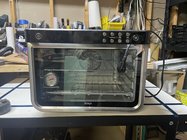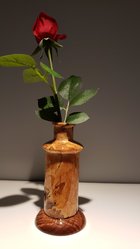I have a large quantity of spalted sugar maple salvaged from a standing dead tree. Naturally, a lot of the most spectacular stuff is so punky as to verge on unworkable. I am looking at using Cactus Juice to harden it up enough for turning. Most of the material has been sawn up into 3" x 7" planks and could be used for small boxes, bowls and hollow forms, although there are a few larger chunks. It is currently around 8-10% moisture content and if roughed out will get to around 6% in my shop at this time of year. I also have access to more and larger similar material.
The TurnTex FAQ section includes this response to a question about punky turning blanks
Yes, Cactus Juice will work fine on bowls. It may get expensive, though, due to how much resin they will take up. Since stabilizing punky bowls is primarily just to to make them turnable, I would suggest just getting a large enough container and just soaking the blanks. In my testing, punky wood will typically double in weight just by soaking. This will not be as well stabilized as if you used vacuum but for the purpose of being able to turn and finish them, it will be just fine. They will be hard and turn without tear out, they just may not be as resistant to moisture as a vacuum stabilized blank. The advantage of just soaking is you will use a little less resin and you don't have to try to get a large vacuum chamber.
No, you do not need to wrap them in foil. The primary reason for wrapping in foil is to contain the mess when some of it bleeds out (part of the process) and to allow you to put more blanks in the oven at one time. If you do not wrap them in foil, be sure to not stack them on each other or you will end up with a bunch of bowl blanks glued together! Also be sure you have a good drip pan under the blanks to catch the bleed out and prevent it from getting all over the inside of your oven!
Do any of you use this technique in lieu of vacuum infusion on largish blanks? I was intending to set up a vacuum chamber and have about $5 invested in an old pressure cooker, but if soaking will do the trick that's ok with me. Do you get acceptable results in the moisture content range I am talking about? For large pieces, would an enameled lobster pot work ok (I saw a 5 gallon one at the thrift store the other day)? The toaster ovens I have seen are a little small for some of the pieces I might make - have any of you set up a larger curing chamber? Finally, do you find that stabilized wood works best with certain finishes? I most often use wiping varnish (Sutherland Welles Hard Oil Sealer).
I am well aware of the saying, "Life's too short to turn crappy wood", but crap is in the eye of the beholder... oh wait, let me get my handkerchief.
The TurnTex FAQ section includes this response to a question about punky turning blanks
Yes, Cactus Juice will work fine on bowls. It may get expensive, though, due to how much resin they will take up. Since stabilizing punky bowls is primarily just to to make them turnable, I would suggest just getting a large enough container and just soaking the blanks. In my testing, punky wood will typically double in weight just by soaking. This will not be as well stabilized as if you used vacuum but for the purpose of being able to turn and finish them, it will be just fine. They will be hard and turn without tear out, they just may not be as resistant to moisture as a vacuum stabilized blank. The advantage of just soaking is you will use a little less resin and you don't have to try to get a large vacuum chamber.
No, you do not need to wrap them in foil. The primary reason for wrapping in foil is to contain the mess when some of it bleeds out (part of the process) and to allow you to put more blanks in the oven at one time. If you do not wrap them in foil, be sure to not stack them on each other or you will end up with a bunch of bowl blanks glued together! Also be sure you have a good drip pan under the blanks to catch the bleed out and prevent it from getting all over the inside of your oven!
Do any of you use this technique in lieu of vacuum infusion on largish blanks? I was intending to set up a vacuum chamber and have about $5 invested in an old pressure cooker, but if soaking will do the trick that's ok with me. Do you get acceptable results in the moisture content range I am talking about? For large pieces, would an enameled lobster pot work ok (I saw a 5 gallon one at the thrift store the other day)? The toaster ovens I have seen are a little small for some of the pieces I might make - have any of you set up a larger curing chamber? Finally, do you find that stabilized wood works best with certain finishes? I most often use wiping varnish (Sutherland Welles Hard Oil Sealer).
I am well aware of the saying, "Life's too short to turn crappy wood", but crap is in the eye of the beholder... oh wait, let me get my handkerchief.
Last edited:


